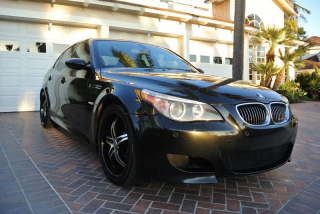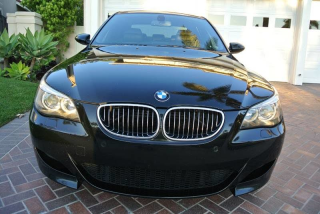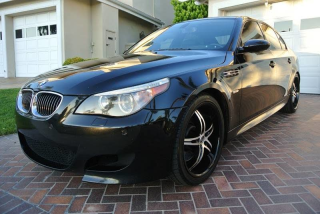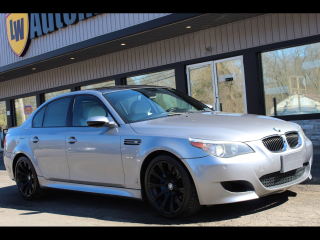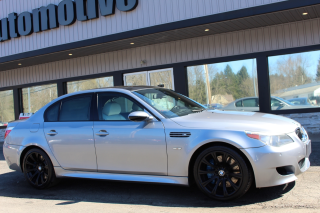The 2006 BMW M5, part of the E60 generation, is a legendary high-performance executive sedan. Introduced for the 2006 model year, it was available as a single, fully-loaded trim. Its standout feature is the naturally aspirated 5.0-liter V10 engine, making it a "super sedan" that redefined the segment. With an original MSRP starting around $81,000, it remains popular for its unique powertrain, engaging driving dynamics, and blend of luxury and raw power, setting it apart from its contemporaries.
The Good
The 2006 BMW M5 offers exhilarating V10 performance, delivering an emotional, high-revving experience. Its sophisticated design balances aggression with executive elegance. Comfort is surprisingly good for a sports sedan, while its strong resale value makes it a practical enthusiast's choice. Though not efficient, its unique character and comprehensive feature set offer immense satisfaction and prestige.
The Bad
Known weaknesses of the 2006 BMW M5 primarily revolve around its complex V10 engine and SMG transmission. High maintenance costs, particularly for rod bearings, VANOS components, and SMG pump failures, are common. Fuel economy is poor, and electronics can be temperamental, requiring careful pre-purchase inspection.
2006 BMW M5: Quick Overview
- Engine: The 2006 BMW M5 was offered with a single, highly specialized engine.
- 5.0-liter (4,999 cc) naturally aspirated S85 V10 engine.
- Features individual throttle bodies for each cylinder.
- High-revving, with a redline of 8,250 RPM.
- Horsepower:
- 500 hp (373 kW) at 7,750 RPM.
- 384 lb-ft (520 Nm) of torque at 6,100 RPM.
- Power can be switched between a P400 (400 hp) comfort mode and P500 (500 hp) or P500 Sport (sharper throttle response) performance modes.
- Transmission:
- 7-speed SMG III (Sequential Manual Gearbox) automated manual transmission.
- Features eleven shift programs for varying driving conditions and aggression.
- No traditional manual transmission option was available for the 2006 model year.
- Fuel Economy (EPA Estimates):
- City: 11 MPG
- Highway: 16 MPG
- Combined: 13 MPG
- 0-60 MPH Acceleration:
- Typically reported in the 4.1 to 4.5-second range, depending on testing conditions and driver skill.
- Top Speed:
- Electronically limited to 155 mph (250 km/h).
- With the optional M Driver's Package (not commonly offered on US 2006 models but available in some markets), the limit could be raised to 190 mph (305 km/h).
- Towing Capacity:
- The BMW M5 is not rated or recommended for towing due to its high-performance nature and specialized components.
- Trim-Level Features (Single Trim): The 2006 M5 came comprehensively equipped.
- Exterior: 19-inch alloy wheels, performance tires, unique aerodynamic body kit, quad exhaust outlets, xenon adaptive headlights.
- Interior: M-specific leather sport seats, multi-function M steering wheel, iDrive infotainment system, automatic climate control, navigation system, logic7 premium audio, head-up display, power sunshade.
- Performance Tech: Dynamic Stability Control (DSC), M Dynamic Mode (MDM), M Variable Differential Lock, Electronic Damping Control (EDC) with three modes (Comfort, Normal, Sport).
2006 BMW M5 Specifications
Vehicle Information
| Year | 2006 |
| Make | BMW |
| Model | M5 |
| Trim | - |
| Style | Rear-Wheel Drive |
| Type | Sedan |
| Category | Mid-Size Car |
Manufacturing Details
| Made In | Germany |
| Manufacturing City | DINGOLFING |
Dimensions
| Doors | 4-Door |
| Curb Weight | 1819.81 kg |
| Gross Vehicle Weight Rating | 2721.55 kg |
| Overall Height | 146.81 cm |
| Overall Length | 485.39 cm |
| Overall Width | 184.66 cm |
| Wheelbase Length | 288.8 cm |
| Standard Seating | 5 |
Engine & Performance
| Engine | 5.0-L V10 |
| Engine Size | 5L |
| Engine Cylinders | 10 |
| Transmission | 7-Speed Automatic |
| Transmission Type | Automatic |
| Transmission Speeds | 7-Speed |
| Drivetrain | Rear-Wheel Drive |
Additional Features
| Anti-Brake System | 4-Wheel ABS |
| Steering Type | Rack & Pinion |
Pricing
| Manufacturer Suggested Retail Price (MSRP) | $81,200 USD |
| Invoice Price | $74,070 USD |
| Delivery Charges | $695 USD |
Vehicle History Report
Vehicle
Specifications
Specifications
Ownership
History
History
All History
Events
Events
NMVTIS Title
History Check
History Check
Salvage/Rebuilt
Check
Check
Accident
Check
Check
Theft
Check
Check
Open Lien
Check
Check
Past Sale
Listings
Listings
Safety
Recalls
Recalls
Odometer
Check
Check
Market Price
Analysis
Analysis
What Problems Does the 2006 BMW M5 Have?
The 2006 BMW M5, while offering phenomenal performance, is also notorious for several frequently reported problems and long-term reliability concerns, primarily centered around its exotic S85 V10 engine and SMG III transmission. One of the most critical issues is premature wear of the rod bearings. This is a common failure point that can lead to catastrophic engine damage if not addressed, often requiring an expensive preventative replacement. Another significant concern is the VANOS system (Variable Valve Timing). Both the high-pressure VANOS pump and solenoids are prone to failure, which can result in rough idling, reduced performance, and costly repairs. The VANOS oil pressure line also has a tendency to burst.
The 7-speed SMG III transmission, while cutting-edge for its time, is a major source of potential headaches. The most common failure is the SMG hydraulic pump and its associated components, like the clutch position sensor or slave cylinder, leading to inability to shift gears or complete loss of drive. Clutch wear is also accelerated in these cars, particularly with aggressive driving.
Throttle actuators are another known failure point, where gears inside the actuator strip, causing reduced engine power and error codes. Electronic issues, such as problems with the iDrive system, various sensors (e.g., crank position sensor, camshaft position sensor), and modules, are also not uncommon, contributing to the car's complex diagnostic challenges.
Regarding recalls, the 2006 M5 has had a few. One notable recall (NHTSA Campaign Number: 06V199000, BMW Recall 06E-A01) involved potential issues with the brake vacuum pump, which could lead to reduced braking assistance. Another recall (NHTSA Campaign Number: 08V384000, BMW Recall 08E-A03) addressed a potential problem with the battery cable connection, which could cause a loss of electrical power.
In general, the M5 is an incredibly complex machine, and its high-performance components operate under immense stress. This translates to higher maintenance and repair costs, as specialized parts and labor are required. Proper and timely maintenance, including preventative measures for known issues, is crucial for long-term ownership. Owners should budget significantly for potential repairs.
The 7-speed SMG III transmission, while cutting-edge for its time, is a major source of potential headaches. The most common failure is the SMG hydraulic pump and its associated components, like the clutch position sensor or slave cylinder, leading to inability to shift gears or complete loss of drive. Clutch wear is also accelerated in these cars, particularly with aggressive driving.
Throttle actuators are another known failure point, where gears inside the actuator strip, causing reduced engine power and error codes. Electronic issues, such as problems with the iDrive system, various sensors (e.g., crank position sensor, camshaft position sensor), and modules, are also not uncommon, contributing to the car's complex diagnostic challenges.
Regarding recalls, the 2006 M5 has had a few. One notable recall (NHTSA Campaign Number: 06V199000, BMW Recall 06E-A01) involved potential issues with the brake vacuum pump, which could lead to reduced braking assistance. Another recall (NHTSA Campaign Number: 08V384000, BMW Recall 08E-A03) addressed a potential problem with the battery cable connection, which could cause a loss of electrical power.
In general, the M5 is an incredibly complex machine, and its high-performance components operate under immense stress. This translates to higher maintenance and repair costs, as specialized parts and labor are required. Proper and timely maintenance, including preventative measures for known issues, is crucial for long-term ownership. Owners should budget significantly for potential repairs.
How long will the 2006 BMW M5 last?
Based on owner data, a well-maintained 2006 BMW M5 can last well over 100,000 miles, with many examples exceeding 150,000 to 200,000 miles. However, achieving this longevity hinges entirely on meticulous and often expensive maintenance habits. The S85 V10 engine, despite its robust design, has specific long-term weaknesses, notably rod bearing wear and VANOS system failures, which demand proactive intervention. The SMG transmission's hydraulic pump is also a known long-term vulnerability. While the chassis and interior components tend to hold up well, the powertrain requires significant investment over time. Owners who skimp on maintenance will face severe durability issues. With diligent care, these cars are durable, but neglecting critical components will inevitably lead to costly breakdowns. Long-term durability is possible, but not inexpensive.
What Technology & Safety Features are Included?
The 2006 BMW M5 was a technological marvel for its time, integrating advanced features into its performance-oriented luxury sedan.
Built-in Tech & Entertainment: At the heart of its cabin technology was the second-generation iDrive infotainment system, controlling navigation, climate, and audio functions via a central controller and dash-mounted screen. While often criticized for its complexity, it offered a comprehensive suite of features including DVD-based navigation, a powerful Logic7 premium audio system with 13 speakers, and a CD player. An auxiliary input for MP3 players was typically optional or standard depending on market and build. The M5 also featured a unique Head-Up Display (HUD), projecting speed, gear, and navigation prompts onto the windshield, a pioneering feature for its class.
Driver-Assistance Features: While not featuring modern autonomous driving aids, the 2006 M5 included advanced systems for its era. These included Dynamic Stability Control (DSC) with multiple modes, including a sportier M Dynamic Mode (MDM) that allowed for more wheel slip. Electronic Damping Control (EDC) offered three suspension settings (Comfort, Normal, Sport) for adjustable ride and handling. Park Distance Control (PDC), with front and rear sensors, assisted with parking maneuvers. Optional features could include active cruise control, though less common on performance models of this vintage.
Safety Features: The M5 was equipped with a robust suite of safety features. Standard passive safety included multiple airbags: dual front, front side, and head protection airbags for both front and rear occupants. Active safety systems included four-wheel anti-lock brakes (ABS) with Brake Fade Compensation, Dynamic Brake Control (DBC), and Cornering Brake Control (CBC). Run-flat tire technology was standard with the 19-inch wheels, providing peace of mind in case of a puncture.
Crash-Test Ratings: Direct crash-test ratings specifically for the 2006 BMW M5 are generally not available from independent organizations like NHTSA or IIHS, as these agencies often focus on more mainstream models or test platforms rather than specific high-performance variants. However, the underlying E60 5-series platform on which the M5 is based performed well in European crash tests (Euro NCAP), typically achieving high marks for occupant protection, suggesting a strong safety foundation for the M5.
Built-in Tech & Entertainment: At the heart of its cabin technology was the second-generation iDrive infotainment system, controlling navigation, climate, and audio functions via a central controller and dash-mounted screen. While often criticized for its complexity, it offered a comprehensive suite of features including DVD-based navigation, a powerful Logic7 premium audio system with 13 speakers, and a CD player. An auxiliary input for MP3 players was typically optional or standard depending on market and build. The M5 also featured a unique Head-Up Display (HUD), projecting speed, gear, and navigation prompts onto the windshield, a pioneering feature for its class.
Driver-Assistance Features: While not featuring modern autonomous driving aids, the 2006 M5 included advanced systems for its era. These included Dynamic Stability Control (DSC) with multiple modes, including a sportier M Dynamic Mode (MDM) that allowed for more wheel slip. Electronic Damping Control (EDC) offered three suspension settings (Comfort, Normal, Sport) for adjustable ride and handling. Park Distance Control (PDC), with front and rear sensors, assisted with parking maneuvers. Optional features could include active cruise control, though less common on performance models of this vintage.
Safety Features: The M5 was equipped with a robust suite of safety features. Standard passive safety included multiple airbags: dual front, front side, and head protection airbags for both front and rear occupants. Active safety systems included four-wheel anti-lock brakes (ABS) with Brake Fade Compensation, Dynamic Brake Control (DBC), and Cornering Brake Control (CBC). Run-flat tire technology was standard with the 19-inch wheels, providing peace of mind in case of a puncture.
Crash-Test Ratings: Direct crash-test ratings specifically for the 2006 BMW M5 are generally not available from independent organizations like NHTSA or IIHS, as these agencies often focus on more mainstream models or test platforms rather than specific high-performance variants. However, the underlying E60 5-series platform on which the M5 is based performed well in European crash tests (Euro NCAP), typically achieving high marks for occupant protection, suggesting a strong safety foundation for the M5.
What Colors Options are Available?
2006 BMW M5 Prices and Market Value
When new, the 2006 BMW M5 carried an original Manufacturer's Suggested Retail Price (MSRP) of approximately $81,200, before options and destination charges. Fully loaded examples could easily exceed $90,000.
In the current used market (as of late 2023/early 2024), prices for a 2006 M5 vary significantly based on condition, mileage, maintenance history, and whether critical preventative maintenance (like rod bearings) has been performed. Prices generally range from $15,000 for higher-mileage or neglected examples to $30,000-$40,000+ for pristine, low-mileage cars with extensive service records.
The M5 experienced significant depreciation in its first decade, typical for high-performance luxury sedans. However, its depreciation has largely leveled off, and it has begun to appreciate slightly for exceptionally well-kept examples. Factors affecting its resale value include the condition of the engine and SMG transmission (receipts for major services are crucial), overall cosmetic condition, and originality. Its unique V10 engine and limited production cement its status as a future classic, helping to stabilize and, for rare examples, increase value.
In the current used market (as of late 2023/early 2024), prices for a 2006 M5 vary significantly based on condition, mileage, maintenance history, and whether critical preventative maintenance (like rod bearings) has been performed. Prices generally range from $15,000 for higher-mileage or neglected examples to $30,000-$40,000+ for pristine, low-mileage cars with extensive service records.
The M5 experienced significant depreciation in its first decade, typical for high-performance luxury sedans. However, its depreciation has largely leveled off, and it has begun to appreciate slightly for exceptionally well-kept examples. Factors affecting its resale value include the condition of the engine and SMG transmission (receipts for major services are crucial), overall cosmetic condition, and originality. Its unique V10 engine and limited production cement its status as a future classic, helping to stabilize and, for rare examples, increase value.
2006 BMW M5 Cost of Ownership
Owning a 2006 BMW M5 is unequivocally costly, not economical. Insurance premiums are high due to its performance, value, and repair complexity. Fuel costs are substantial, as its V10 engine requires premium fuel and delivers poor efficiency (around 13 MPG combined). Maintenance is frequent and expensive, particularly for specialized components like the SMG transmission and VANOS system. Critical preventative repairs, such as rod bearing replacement, can run into thousands of dollars. General repair costs for any issue are elevated due to BMW's premium parts and specialized labor. Long-term ownership demands a significant budget for proactive upkeep and potential major repairs, making it a passion purchase rather than a practical one.
2006 BMW M5 Fuel Efficiency
Fuel Type
Gasoline
Fuel Capacity
68.06 liters
City Mileage
9.1 km/l
Highway Mileage
5.87 km/l
2006 BMW M5 Safety Rating
NHTSA
IIHS
2006 BMW M5 Warranty
Basic
Original warranty
48 months / 50,000 miles
Estimated remaining
Expired
Powertrain
Original warranty
48 months / 50,000 miles
Estimated remaining
Expired
Rust
Original warranty
144 months / unlimited miles
Estimated remaining
Expired
2006 BMW M5 Insurance
Insurance for a 2006 BMW M5 is moderately priced, reflecting its status as a Sedan with strong safety ratings and
reasonable repair costs.
reasonable repair costs.
How Does the 2006 BMW M5 Compare to Other Sedan?
The 2006 BMW M5 operated in a fiercely competitive, high-performance executive sedan segment, primarily facing off against the Mercedes-Benz E63 AMG and Audi RS6 (though the C6 RS6 was not available in the US for 2006, the C5 RS6 was ending production).
Performance: The M5's naturally aspirated 500 hp V10 was unique. It offered a high-revving, intoxicating soundtrack and razor-sharp throttle response. The Mercedes-Benz E63 AMG (from 2007, but the E55 AMG was its closest contemporary) used a supercharged V8 (E55) or later a naturally aspirated 6.2L V8 (E63) with immense torque, feeling more like a blunt instrument of speed. The M5 felt more precise and driver-focused.
Features: All rivals offered luxurious interiors with advanced features for the era. The M5's iDrive was pioneering but controversial. AMG models typically offered a more straightforward infotainment experience. All featured premium audio, navigation, and plush leather. The M5's Head-Up Display was a standout tech feature.
Reliability: This is where the M5 often lags behind. Its complex S85 V10 and SMG III transmission are known for expensive, recurring issues (rod bearings, VANOS, SMG pump). The E55/E63 AMG, while still high-maintenance, often faced fewer catastrophic powertrain failures, though air suspension and supercharger clutch issues were not uncommon. The Audi RS6, with its twin-turbo V8, also had its own set of expensive complexities, like DRC suspension and turbo issues. Overall, none were "reliable" in the conventional sense, but the M5's specific vulnerabilities stood out.
Price: New, they were all in a similar high-$80k to $100k+ bracket. Used, the M5 can now be found for similar or slightly less than comparable AMG models, largely due to its perceived higher maintenance risk.
Alternatives:
Performance: The M5's naturally aspirated 500 hp V10 was unique. It offered a high-revving, intoxicating soundtrack and razor-sharp throttle response. The Mercedes-Benz E63 AMG (from 2007, but the E55 AMG was its closest contemporary) used a supercharged V8 (E55) or later a naturally aspirated 6.2L V8 (E63) with immense torque, feeling more like a blunt instrument of speed. The M5 felt more precise and driver-focused.
Features: All rivals offered luxurious interiors with advanced features for the era. The M5's iDrive was pioneering but controversial. AMG models typically offered a more straightforward infotainment experience. All featured premium audio, navigation, and plush leather. The M5's Head-Up Display was a standout tech feature.
Reliability: This is where the M5 often lags behind. Its complex S85 V10 and SMG III transmission are known for expensive, recurring issues (rod bearings, VANOS, SMG pump). The E55/E63 AMG, while still high-maintenance, often faced fewer catastrophic powertrain failures, though air suspension and supercharger clutch issues were not uncommon. The Audi RS6, with its twin-turbo V8, also had its own set of expensive complexities, like DRC suspension and turbo issues. Overall, none were "reliable" in the conventional sense, but the M5's specific vulnerabilities stood out.
Price: New, they were all in a similar high-$80k to $100k+ bracket. Used, the M5 can now be found for similar or slightly less than comparable AMG models, largely due to its perceived higher maintenance risk.
Alternatives:
- Mercedes-Benz E63 AMG (W211): A strong alternative if you prefer a more torque-rich, less frantic V8 character, and a slightly more conventional automatic transmission. Potentially better long-term reliability for some powertrain components, but still costly to maintain.
- Audi S6 (C6, V10): While not an RS6, the C6 S6 shared the M5's V10 spirit (though a different Lamborghini-derived V10, 435 hp) and offered quattro AWD. It's a more understated, comfortable, and less aggressive performance sedan, potentially with fewer extreme powertrain issues than the M5, though still complex.
- Porsche Panamera (later model years): For similar driving dynamics and luxury, but with modern reliability and tech, a used Panamera from later generations offers a compelling package, albeit at a higher used price point.
Final Verdict: Is the 2006 BMW M5 a Good Sedan?
The 2006 BMW M5 is ideal for a passionate automotive enthusiast who desires an exhilarating, high-revving V10 experience, is comfortable with significant ownership costs, and appreciates a blend of executive luxury and raw performance. It's for someone who views a car as a mechanical art piece, not merely transportation.
Is it worth buying? Absolutely, but only under very specific conditions. Buy it as a used vehicle, as new pricing is long gone. There's only one trim, so focus is on condition. It's worth buying if you find an example with impeccable, documented service history, ideally with proof of preventative maintenance like rod bearing replacement and SMG pump service. You must also have a substantial "repair fund" set aside, as unexpected issues are common and expensive. It's not a daily driver for the budget-conscious, but a weekend thrill machine for those who understand its unique charm and accept its demands.
Is it worth buying? Absolutely, but only under very specific conditions. Buy it as a used vehicle, as new pricing is long gone. There's only one trim, so focus is on condition. It's worth buying if you find an example with impeccable, documented service history, ideally with proof of preventative maintenance like rod bearing replacement and SMG pump service. You must also have a substantial "repair fund" set aside, as unexpected issues are common and expensive. It's not a daily driver for the budget-conscious, but a weekend thrill machine for those who understand its unique charm and accept its demands.
